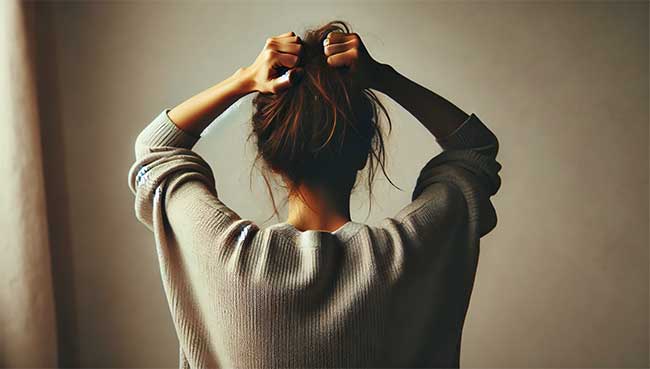
Permanent hair loss can be a harrowing ordeal, and although it’s not a major health risk, it’s an undeniable sign of aging.
A major cause of hair loss is genetics. If your mother or father has thinning hair or a receding hairline, you will likely face the same fate.
However, your inherited DNA sequence is not the only factor impacting hair loss. Other factors contribute to the weakening or thinning of your hairline outside the genetic component.
Regardless of the underlying cause, if you want to slow hairline shedding, then there are ways you can reverse this rapid loss of hair.
However, that starts by knowing what’s causing your hair loss in the first place. If not genetics, then what?
Let’s dive into some potential reasons why you may be facing substantial hair loss.
Types of Hair Loss
It’s important to consider the type of hair loss your body is experiencing. This is for doctors to make an accurate diagnosis and craft an effective treatment management plan for it.
Each condition may showcase different causes and symptoms, which will entail different solutions to alleviate the issue.
Here are some hair loss symptoms that you may be experiencing.
- Gradual thinning on the front of the head: This type of hair loss affects the hair on top of the forehead or the hairline. It usually affects the sides first, particularly for men.
- Receding hairline with small hair strands: Hair strands, when growing, become finer and weaker over time.
- Patchy bald spots: Some hair may fall off in clusters around the scalp, eyebrows, or beard. The skin may become itchy before hair starts to fall off.
- Localised hair loss with redness: A permanent type of hair loss that occurs when inflammation destroys hair follicles.
- Sudden excessive shedding: An acute case of physical or emotional trauma can cause hair to loosen by the handful. This can happen even with simple and gentle tugging, but this case is usually temporary once the cause of the trauma subsides.
- Full-body hair loss: Loss of hair that spreads all over the body from head to toe.
- Scaly patches on the scalp: Broken hair accompanied by redness or flakes. This may indicate a parasitical infection.
If you’re experiencing one or multiple types of hair loss as indicated above, it’s in your best interest to contact a haircare specialist to get the help you need to restore your hair volume and strength.
These medical professionals can guide you toward the most effective treatment for your specific case. In some cases, medical procedures such as a Gro Clinics Wellington hair transplant may be necessary to resolve the loss of hair.
Why You’re Losing Hair: 5 Possible Reasons
With 70% of men and 40% of women bound to face hair loss in their lifetime, it’s a good idea to get some awareness of the potential causes of hair loss.
Let’s get to the bottom of why you may be losing hair.
- Chronic Stress
Do you feel immensely stressed by your daily responsibilities? Do you have a hard time winding down after a hard day’s work? And—most crucially—are you losing patches or clumps of hair without reason?
If you answered in the affirmative to all these questions, then you may be a victim of the effects of stress. High stress levels trigger an increase in cortisol, a hormone that can disrupt the natural hair growth cycle. In particular, this condition causes the immune system to attack hair follicles, pushing them into a resting phase and leading to their falling out.
This condition can cause your hair to shed at a higher rate than before, which can be a big confidence killer. If you’ve undergone a traumatic or emotionally charged event and are experiencing hair loss, the underlying stress could be directly affecting it. Once the stressful situation subsides, then you can restore the balance and experience normal hair growth again.
- Nutritional Deficiencies
Another potential hair-loss agent is a lack of vital nutrients in the body.
Your hair, just like the rest of your body, demands a healthy amount of nutrients to ensure its vitality and strength. Without enough of these nutrients, your hair could shed or grow significantly slower, making your hair look less vibrant than it once did.
As such, ensure that you’re eating enough and supplementing yourself with the right vitamins to improve your hair growth. One particularly crucial mineral for people facing hair loss is iron. If you have low levels of iron, inadequate oxygen will make it to your hair follicles, causing it to weaken. Other vitamins like zinc, biotin, protein, and vitamin D also need to be above daily levels for men and women to ensure healthy hair growth.
To combat these deficiencies, eating a diet rich in the vitamins and nutrients you’re missing is the way to go. Lean meats and nuts are good for protein, while leafy greens and whole grains are good for everything else. By replenishing your vitamin stores, your body will have enough resources to grow its hair.
- Poor Scalp Health
A healthy scalp allows hair to flow naturally and vibrantly. If you’re facing underlying health conditions that get in the way of optimal hair growth, this can prevent sufficient hair from growing normally.
Some of these hair conditions include a bad case of dandruff, seborrheic dermatitis, and psoriasis. These conditions can cause inflammation, itchiness, and clogged hair follicles—leading to brittle strands and a less-than-ideal hairline.
Moreover, fungal infections like ringworm infections are common occurrences in people with poor scalp hygiene. This can also cause problems in hair growth.
To counter this, it’s essential to address the issue directly based on the condition that you may be facing.
If you have inflammation, for instance, using shampoos with tea tree oil or ketoconazole can promote a balanced scalp environment. If you have a ringworm infection, you should take the appropriate prescription for it to encourage a healthier head of hair.
If you’re unsure how to best approach scalp treatment, you should consult with a dermatologist or haircare specialist to address your condition in a tailor-fit manner.
- Hormonal Imbalances
Besides problems in your scalp, you also have bodily problems to account for as potential hair loss sources. Hormonal fluctuations can influence the way your body grows, and this affects both men and women.
For instance, as a man ages, they’ll produce less testosterone. This can lead to androgenetic alopecia or male-pattern baldness (MPB), which can shrink hair follicles over time. Thyroid hormone disorders, particularly hypothyroidism and hyperthyroidism, can also impact the ability of the hair follicles to produce hair.
Women aren’t exempt from this condition too, as menopause, pregnancy, and the stress from childbirth can lead to hormonal issues. In such cases, addressing these problems through medical intervention and lifestyle changes may be warranted to stabilise and slow down hair loss.
- Medical Treatments
In some cases, sudden hair loss could be linked to treatments and medications for other health problems a person may be facing.
For instance, chemotherapy and radiation therapy target and destroy cancer cells. Unfortunately, this can also result in the unwanted side effect of damage to hair-growing cells, resulting in widespread hair loss.
Some medications like SSRIs and blood pressure medications can also interfere with the normal cycle of hair growth, causing hair to thin or recede at a more rapid pace.
Steroid and thyroid medication misuse can also lead to hormonal imbalances, which may quickly result in hair loss. If you suspect that your medication or treatment plan is contributing to hair loss, it’s important to raise it to your doctor to have them switch your medication plan or change your dosage accordingly.
- Hair Styles
Some hairstyles may inadvertently damage hair follicles, leading to a slowdown in hair growth and a subtle but steady hairline recession.
The culprits? Tight ponytails, buns, and braids are some common hairstyles that can gradually thin the hairline because of the constant tension against it. Dreadlocks and weaves also contribute to hair loss for the same reason.
Moreover, some hair styling equipment produces heat and wind pressure that can break and weaken healthy hair strands. Chemical treatments can also damage hair cuticles and make them more brittle.
If you want to ensure that your hair remains healthy as you age, then limit heat exposure and use hair styling products made from nourishing ingredients that don’t damage your hair in the long term.
All the best in keeping your hair vibrant!
 My Favourites
My Favourites









Speak Your Mind